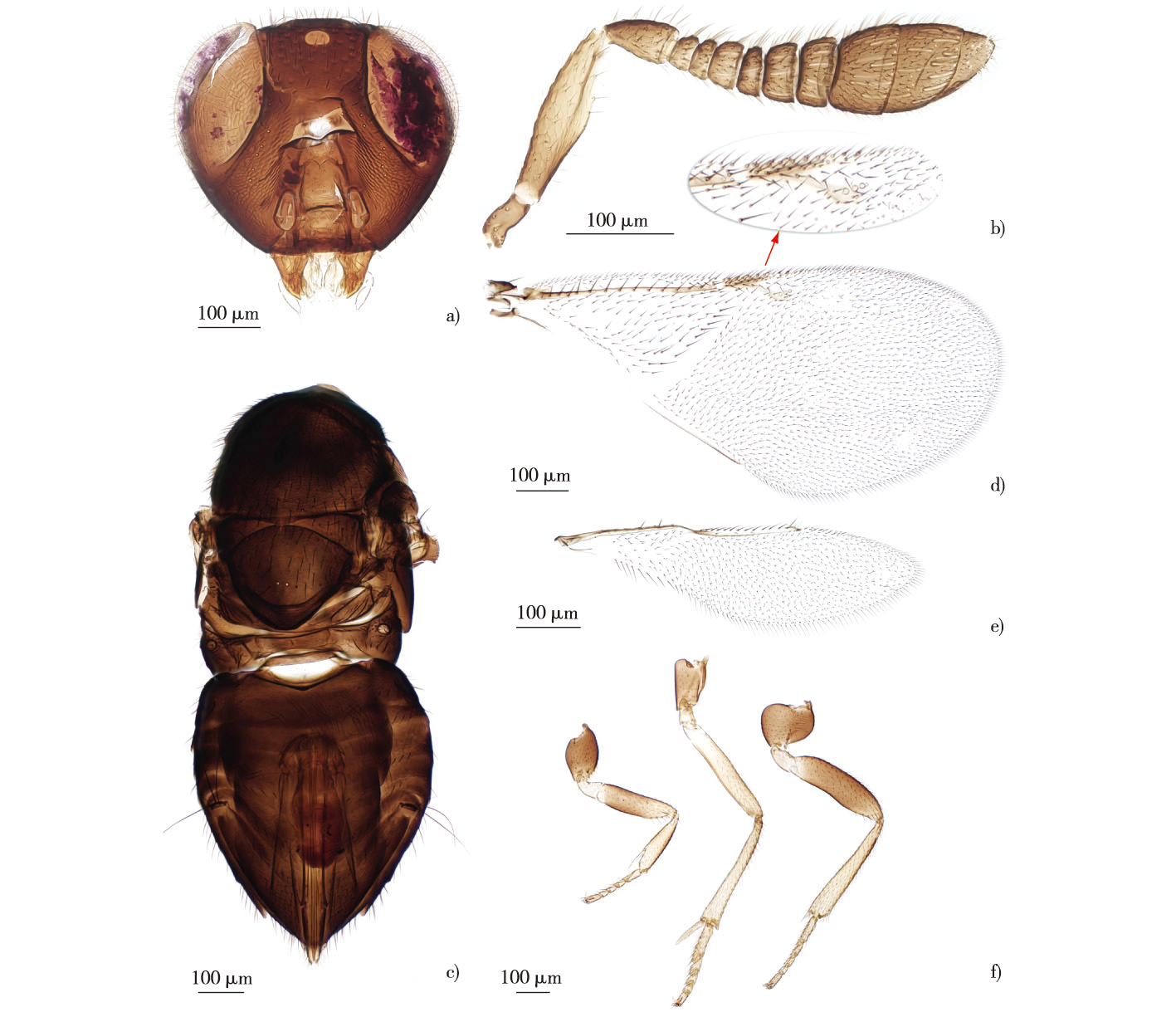【目的】进一步丰富我国及天津市的生物多样性,为跳小蜂科物种的系统发育研究奠定基础。【方法】在天津市天津农学院东校区内开展了跳小蜂的采集工作。利用马来氏网采集昆虫标本,并将其保存于含有无水乙醇的收集瓶中。将采集的昆虫标本带回实验室后,在体视显微镜下根据其形态学特征分拣出跳小蜂科昆虫标本,对目标昆虫进行解剖,并置于5%(体积分数)NaOH溶液中透明后,利用阿拉伯树胶封片法分别将解剖下来的头、胸腹、触角、前翅、后翅、前足、中足、后足等部位压制成玻片标本。用带刻度的目镜在体视显微镜下对各特征部位进行测量,并对各特征部位拍照。最后,依据小蜂的形态特征进行分类鉴定。【结果】对标本进行鉴定认为是蝇克跳小蜂属1中国新记录种。该种雌蜂体长1.10~1.42 mm,大体黑褐色;翅透明;前足腿节基部和端部、中足腿节黄褐色,中足基节褐色,所有胫节和跗节黄褐色;头部长为宽的83%,额顶宽为头宽的0.37倍,具清晰的载毛刻窝;触角柄节中部膨大,长为最宽处的4倍,各索节均宽大于长,棒节3节,长于各索节长度之和,端部有明显的斜切;上颚3齿,后齿较圆钝;胸部密被刚毛,中胸盾片具鳞形刻纹,小盾片具多边形网纹;前翅长约为宽的2倍,无毛斜带开放;中足胫节距为中足胫节长的1/3,略短于中足基跗节;腹部心形,产卵器略伸出。此外,提供了该种雌性成虫的形态特征图及该属中国已知种雌性检索表。【结论】经鉴定证实,检视标本为中国新记录种——敌扑蝇克跳小蜂(Exoristobia dipterae)。
【Objective】This study aimed to further enrich the biodiversity of Tianjin and China, and lay a foundation for the phylogenetic study of Encyrtidae species.【Method】The collection of Encyrtidae wasps was carried out in the east campus of Tianjin Agricultural University; the specimens were collected using a Malaise trap and stored in collection bottles containing absolute ethanol. After bringing the collected insect specimens back to the laboratory, the Encyrtidae wasps were sorted out according to their morphological characteristics under a stereomicroscope; the target wasps were dissected, and after becoming transparent in 5% (volume fraction) NaOH, the dissected head, thorax, gaster, antenna, fore wing, hind wing, fore leg, mid leg, and hind leg were successively mounted in Arabian gum on slides. Each characteristic part was photographed and measured under a stereomicroscope with a graduated eyepiece. Finally, the wasps were classified and identified according to their morphological characteristics.【Result】This study found a newly recorded species of the genus Exoristobia in China. The length of the females varies from 1.10-1.42 mm, body was generally dark brown, wings hyaline, basal and distal of fore coxa yellowish brown, mid femora also yellowish brown, mid coxa brown, all tarsi yellowish brown, head 0.83× as high as wide in frontal view, frontovertex 0.37× head width in dorsal view, with distinct piliferous punctures, antenna scape 4× as long as broad and broadest in the middle, all funicle segments broader than long, clava three-segmented, as long as all funicular segments combined, apex distinct obliquely truncate, mandible with three teeth, the rear tooth round and blunt, thorax densely covered with setae, mesoscutum with fine, scale-like sculpture, scutellum with reticulate sculpture, fore wing 2× as long as wide, linea calva open posteriorly, uninterrupted, length of mid tibial spur one-third of the mid tibia and slightly shorter than the corresponding basitarsus, abdomen heart-shaped, with the ovipositor slightly extended. The photos of female adults and the key to known Chinese species of Exoristobia were also provided. 【Conclusion】The appraisal confirmed that the specimen examined, Exoristobia dipterae (Risbec, 1951), was a newly recorded species in China.
 PDF(2232 KB)
PDF(2232 KB)


 PDF(2232 KB)
PDF(2232 KB)
 PDF(2232 KB)
PDF(2232 KB)
